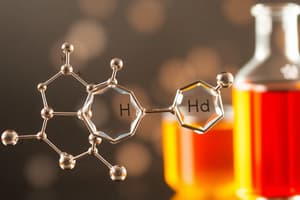Podcast
Questions and Answers
Which reaction produces thionyl chloride when carboxylic acid is treated with $SOCl_2$?
Which reaction produces thionyl chloride when carboxylic acid is treated with $SOCl_2$?
- $RCOCI + SO_2 + HCl$
- $RCOOH + PCl_3 \longrightarrow 3RCOCl + H_3PO_3$
- $RCOOH + PCl_5 \longrightarrow 3RCOCl + H_3PO_3$
- $RCOOH + SOCl_2 \longrightarrow RCOCl + SO_2 + HCl$ (correct)
What is the main advantage of using thionyl chloride ($SOCl_2$) over $PCl_5$ in the reaction with carboxylic acids?
What is the main advantage of using thionyl chloride ($SOCl_2$) over $PCl_5$ in the reaction with carboxylic acids?
- Yields higher concentration of acyl chlorides
- Simplifies purification of products (correct)
- Reacts faster with carboxylic acids
- Produces less toxic byproducts
What is the final product of heating ammonium acetate at high temperature?
What is the final product of heating ammonium acetate at high temperature?
- Ester
- Alcohol
- Acetamide (correct)
- Aldehyde
What byproducts are formed when carboxylic acids react with $PCl_5$?
What byproducts are formed when carboxylic acids react with $PCl_5$?
Which of the following reactions correctly represents the formation of ammonium benzoate from benzoic acid?
Which of the following reactions correctly represents the formation of ammonium benzoate from benzoic acid?
What type of compound is produced when carboxylic acids react with ammonia and are subsequently heated?
What type of compound is produced when carboxylic acids react with ammonia and are subsequently heated?
What is a major byproduct when carboxylic acids react with thionyl chloride ($SOCl_2$)?
What is a major byproduct when carboxylic acids react with thionyl chloride ($SOCl_2$)?
Ammonium acetate can be converted to acetamide upon further heating.
Ammonium acetate can be converted to acetamide upon further heating.
What is formed when benzoic acid reacts with ammonia?
What is formed when benzoic acid reacts with ammonia?
Upon heating, ammonium benzoate yields ______ and water.
Upon heating, ammonium benzoate yields ______ and water.
Match the following reactions to their products:
Match the following reactions to their products:
Which of the following reactions represents the conversion of a carboxylic acid to an acyl chloride?
Which of the following reactions represents the conversion of a carboxylic acid to an acyl chloride?
Flashcards are hidden until you start studying
Study Notes
Reactions with PCl5, PCl3, and SOCl2
- The hydroxyl group in carboxylic acids can be replaced by chlorine when reacting with phosphorus chlorides.
- SOCl2SOCl_2SOCl2 (thionyl chloride) is preferred due to simpler purification processes and cleaner reaction byproducts.
- Byproducts of reactions with PCl5PCl_5PCl5 and PCl3PCl_3PCl3 include POCl3POCl_3POCl3 (phosphoryl chloride) and HClHClHCl (hydrochloric acid).
- Reactions yield acyl chlorides (RCOCl):
- Reaction with PCl5PCl_5PCl5:
- RCOOH+PCl5→3RCOCl+H3PO3RCOOH + PCl_5 \rightarrow 3RCOCl + H_3PO_3RCOOH+PCl5→3RCOCl+H3PO3
- Reaction with PCl3PCl_3PCl3:
- RCOOH+PCl3→3RCOCl+H3PO3RCOOH + PCl_3 \rightarrow 3RCOCl + H_3PO_3RCOOH+PCl3→3RCOCl+H3PO3
- With SOCl2SOCl_2SOCl2 (thionyl chloride):
- RCOOH+SOCl2→RCOCl+SO2+HClRCOOH + SOCl_2 \rightarrow RCOCl + SO_2 + HClRCOOH+SOCl2→RCOCl+SO2+HCl
- Reaction with PCl5PCl_5PCl5:
Reactions with Ammonia
- Carboxylic acids react with ammonia to form ammonium salts, which can yield amides upon heating.
- Example reactions:
- Acetic acid and ammonia produce ammonium acetate:
- CH3COOH+NH3→CH3COONH4CH_3COOH + NH_3 \rightarrow CH_3COONH_4CH3COOH+NH3→CH3COONH4
- Heating ammonium acetate leads to acetamide:
- CH3COONH4→CH3CONH2+H2OCH_3COONH_4 \rightarrow CH_3CONH_2 + H_2OCH3COONH4→CH3CONH2+H2O
- Benzoic acid reacts with ammonia to form ammonium benzoate:
- C6H5COOH+NH3→C6H5COONH4C_6H_5COOH + NH_3 \rightarrow C_6H_5COONH_4C6H5COOH+NH3→C6H5COONH4
- Heating ammonium benzoate produces benzamide:
- C6H5COONH4→C6H5CONH2+H2OC_6H_5COONH_4 \rightarrow C_6H_5CONH_2 + H_2OC6H5COONH4→C6H5CONH2+H2O
- Acetic acid and ammonia produce ammonium acetate:
Reactions with PCl5, PCl3, and SOCl2
- The hydroxyl group in carboxylic acids can be replaced by chlorine when reacting with phosphorus chlorides.
- SOCl2SOCl_2SOCl2 (thionyl chloride) is preferred due to simpler purification processes and cleaner reaction byproducts.
- Byproducts of reactions with PCl5PCl_5PCl5 and PCl3PCl_3PCl3 include POCl3POCl_3POCl3 (phosphoryl chloride) and HClHClHCl (hydrochloric acid).
- Reactions yield acyl chlorides (RCOCl):
- Reaction with PCl5PCl_5PCl5:
- RCOOH+PCl5→3RCOCl+H3PO3RCOOH + PCl_5 \rightarrow 3RCOCl + H_3PO_3RCOOH+PCl5→3RCOCl+H3PO3
- Reaction with PCl3PCl_3PCl3:
- RCOOH+PCl3→3RCOCl+H3PO3RCOOH + PCl_3 \rightarrow 3RCOCl + H_3PO_3RCOOH+PCl3→3RCOCl+H3PO3
- With SOCl2SOCl_2SOCl2 (thionyl chloride):
- RCOOH+SOCl2→RCOCl+SO2+HClRCOOH + SOCl_2 \rightarrow RCOCl + SO_2 + HClRCOOH+SOCl2→RCOCl+SO2+HCl
- Reaction with PCl5PCl_5PCl5:
Reactions with Ammonia
- Carboxylic acids react with ammonia to form ammonium salts, which can yield amides upon heating.
- Example reactions:
- Acetic acid and ammonia produce ammonium acetate:
- CH3COOH+NH3→CH3COONH4CH_3COOH + NH_3 \rightarrow CH_3COONH_4CH3COOH+NH3→CH3COONH4
- Heating ammonium acetate leads to acetamide:
- CH3COONH4→CH3CONH2+H2OCH_3COONH_4 \rightarrow CH_3CONH_2 + H_2OCH3COONH4→CH3CONH2+H2O
- Benzoic acid reacts with ammonia to form ammonium benzoate:
- C6H5COOH+NH3→C6H5COONH4C_6H_5COOH + NH_3 \rightarrow C_6H_5COONH_4C6H5COOH+NH3→C6H5COONH4
- Heating ammonium benzoate produces benzamide:
- C6H5COONH4→C6H5CONH2+H2OC_6H_5COONH_4 \rightarrow C_6H_5CONH_2 + H_2OC6H5COONH4→C6H5CONH2+H2O
- Acetic acid and ammonia produce ammonium acetate:
Studying That Suits You
Use AI to generate personalized quizzes and flashcards to suit your learning preferences.




